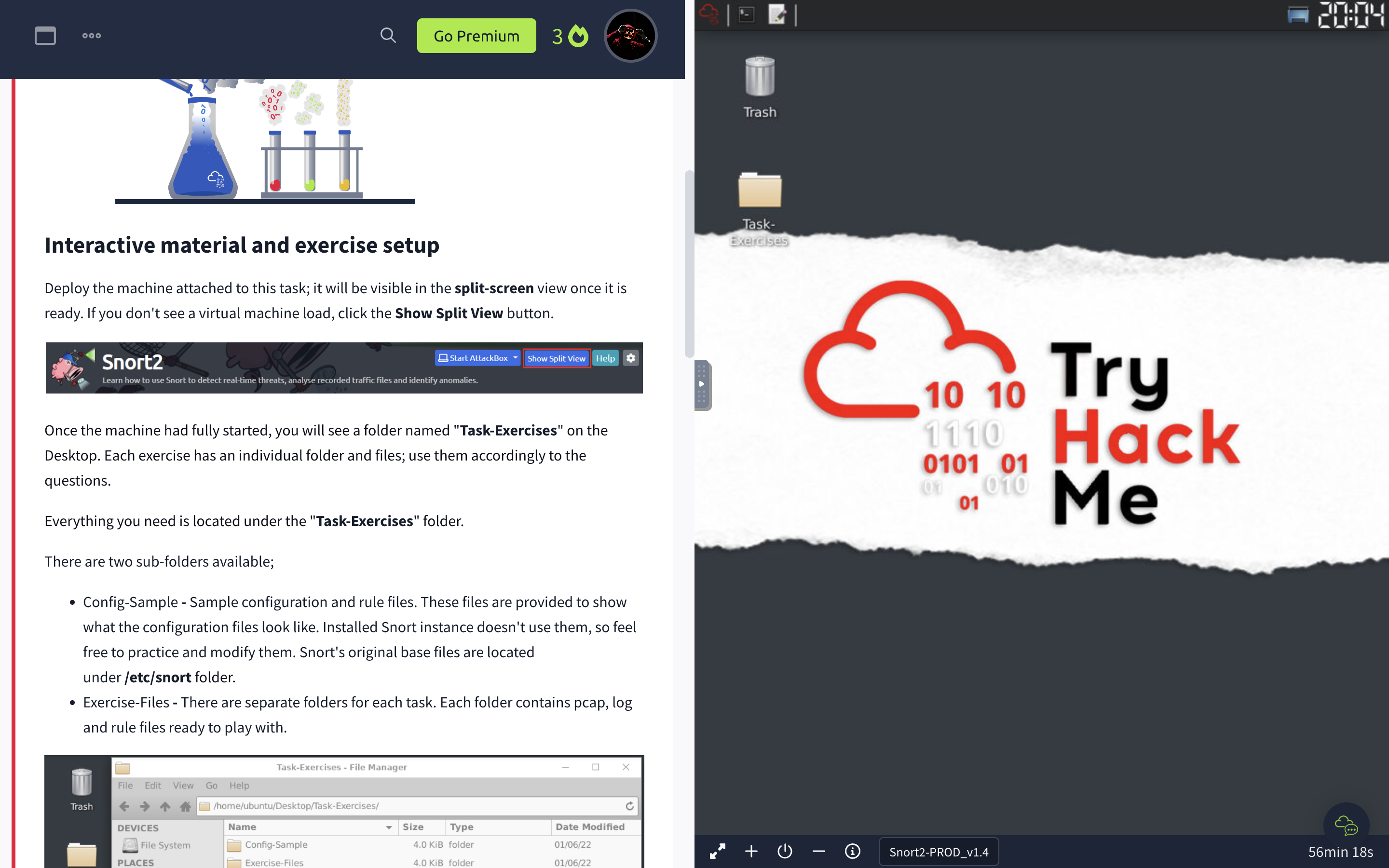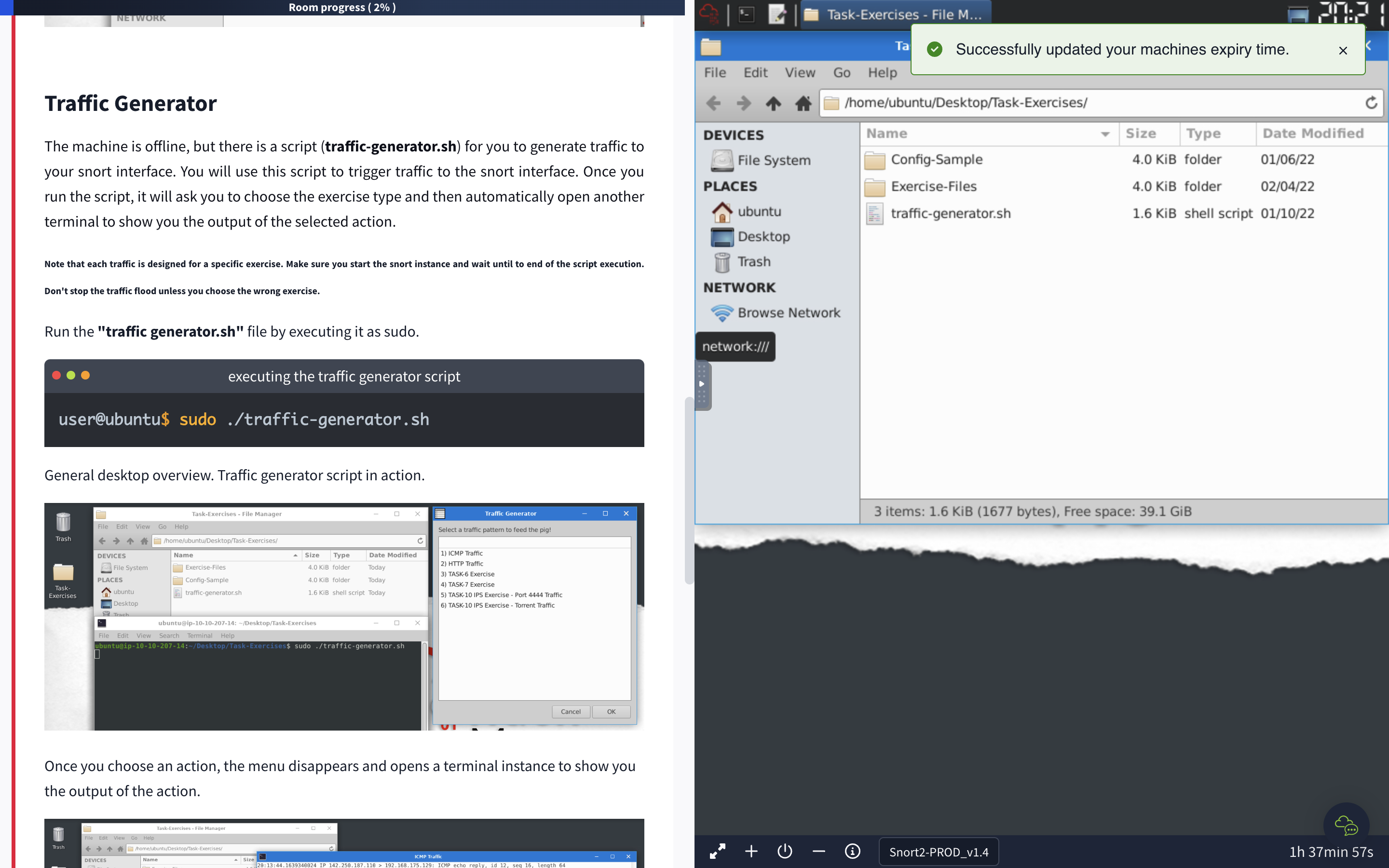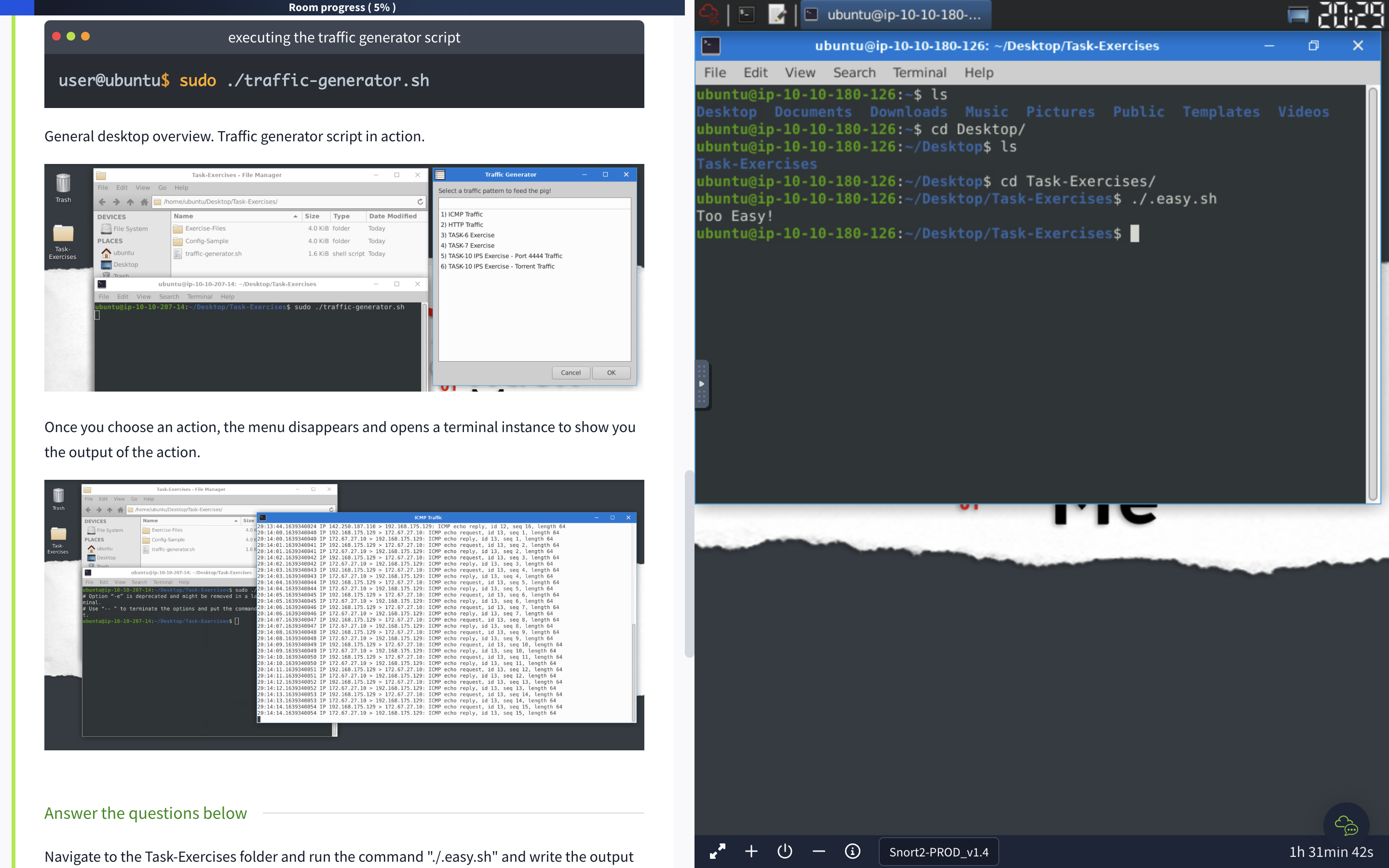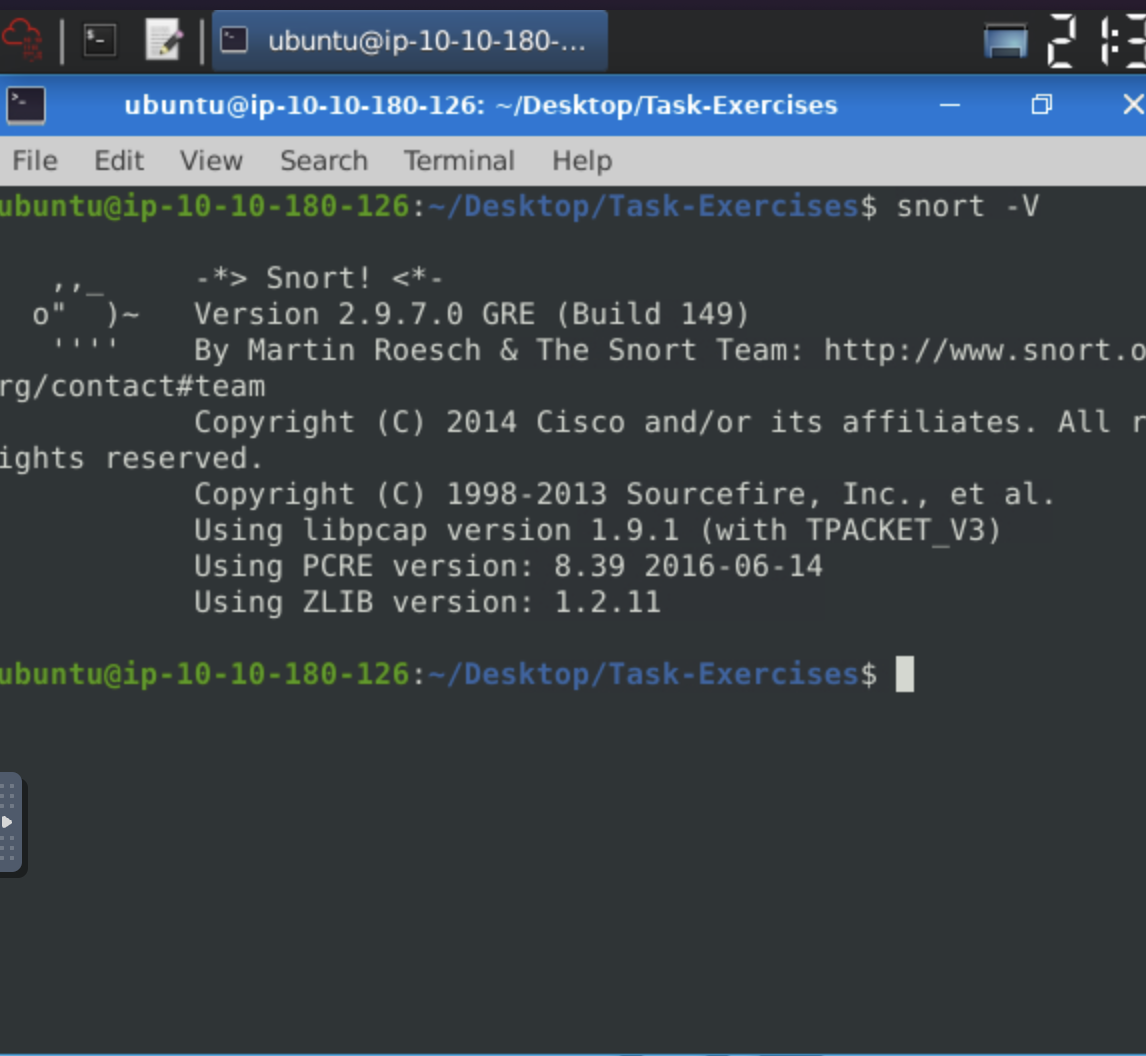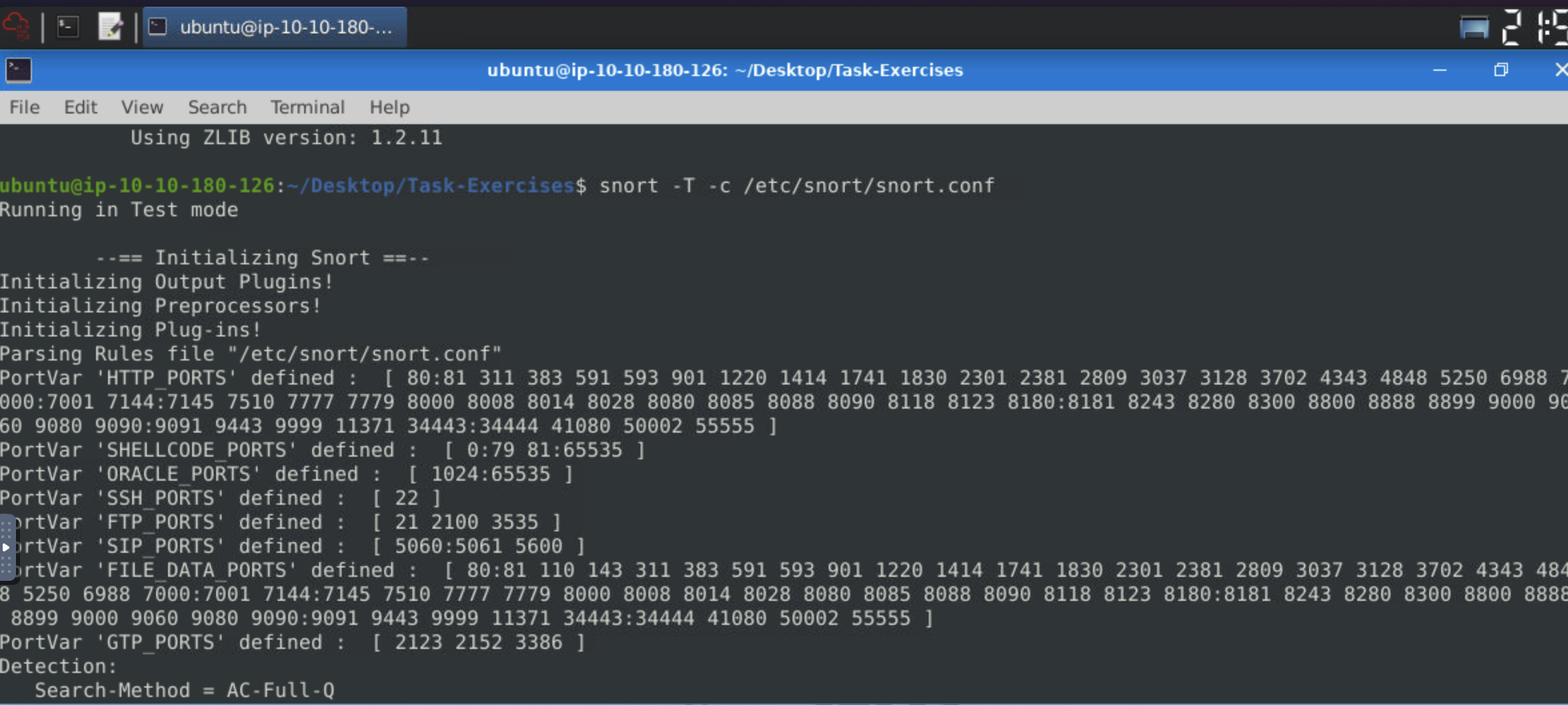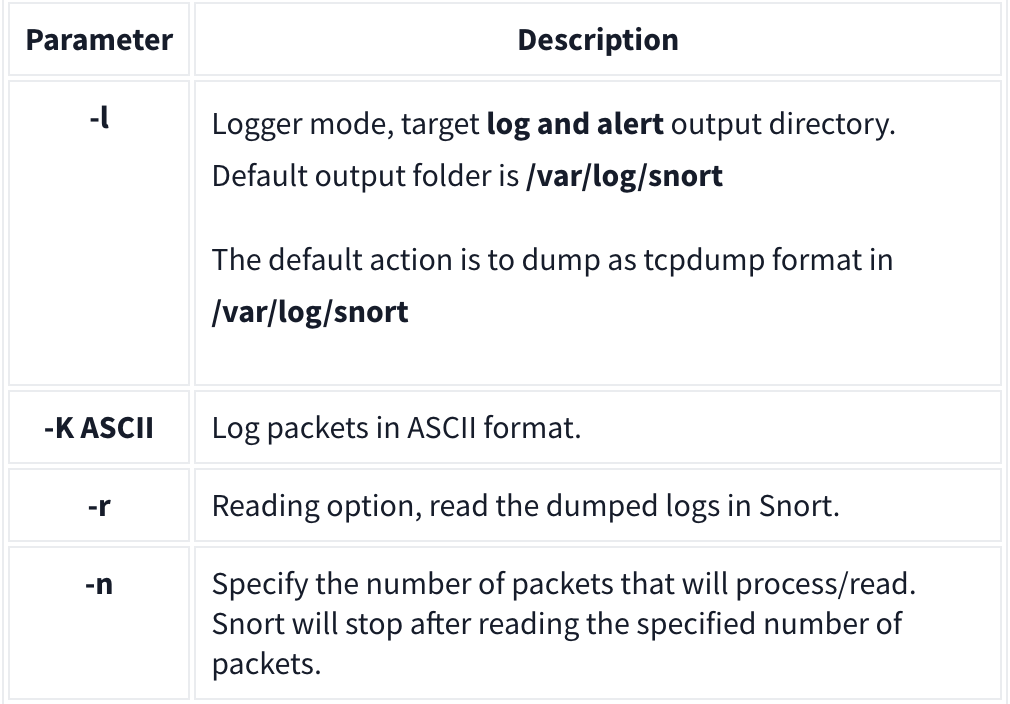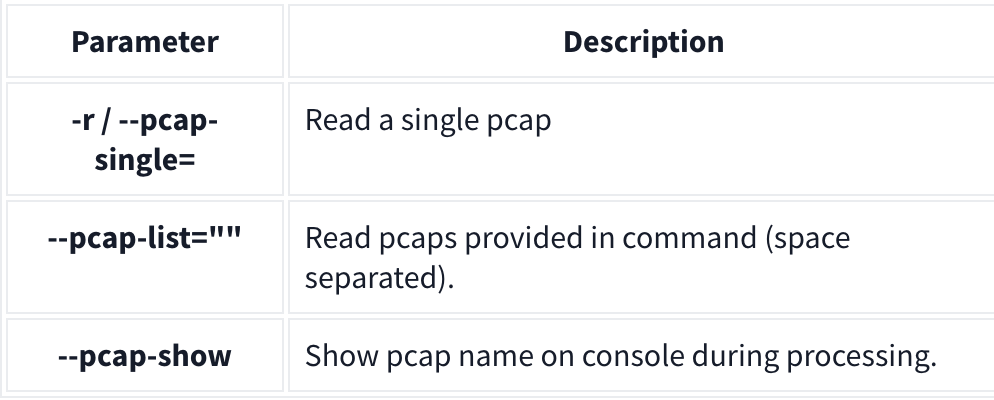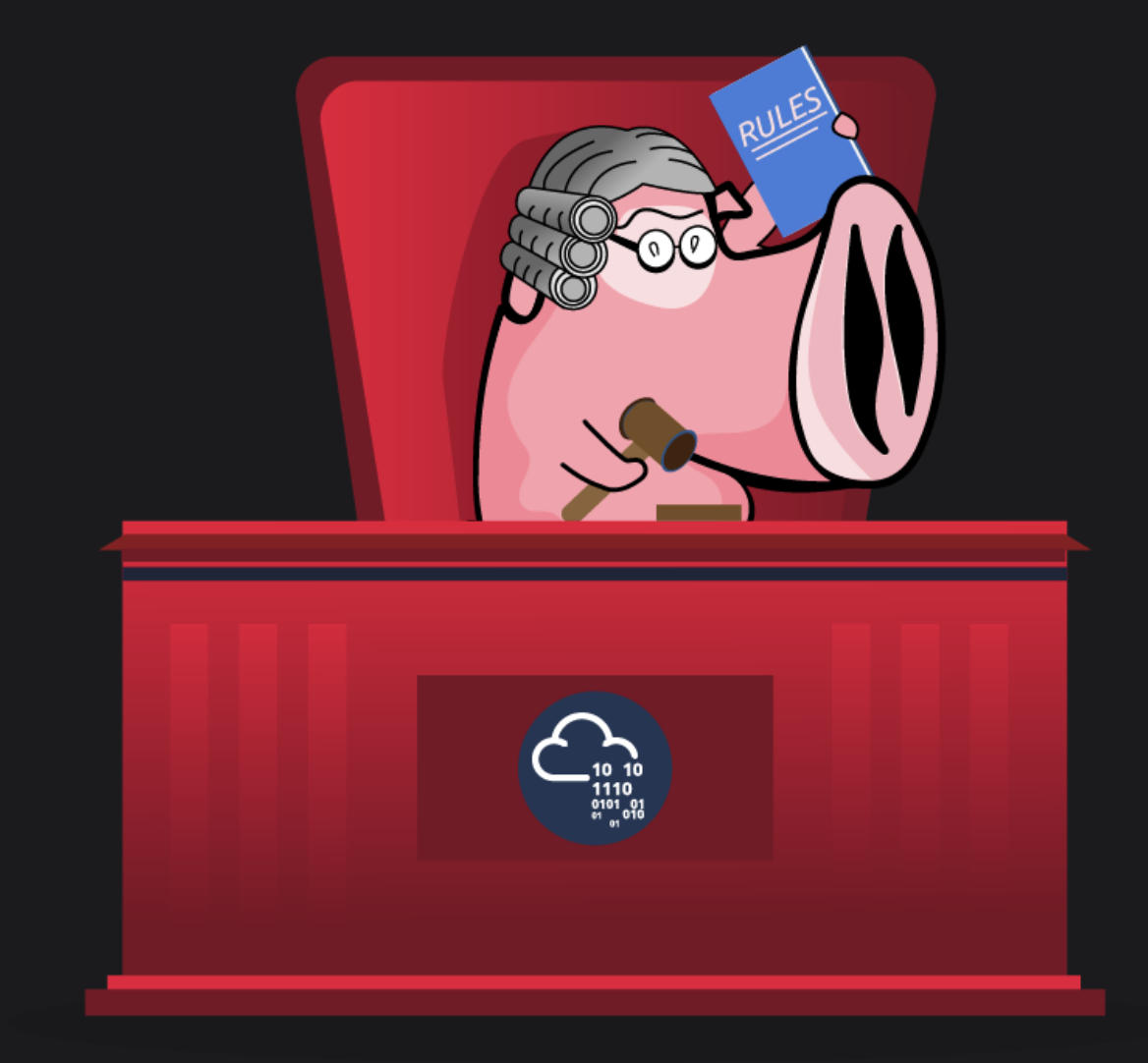Sws101_snort_thm
Snort
Introduction
In this room we will be learning basic Linux command-line functionalities like general system navigation and Network fundamentals (ports, protocols and traffic data).
Interactive Material and VM
First of all I started the machine to do all the task in this room.
After successfully starting the machine it popped a desktop where navigated to the “Task-Exercise folder” and found the following:
Config-Sample - Sample configuration and rule files.
Exercise-Files - There are separate folders for each task.
traffic-generator.sh - generate traffic to your snort interface.
So as instructed in the task I went to the “Tash-Exercise” and and ran tthe command ./.eash.sh. the output given to me was “Too Easy!”.
Introduction to IDS/IPS
Intrusion Detection System (IDS)
IDS is a passive monitoring solution for detecting possible malicious activities/patterns, abnormal incidents, and policy violations. generating alerts for each suspicious event.
There are two main types of IDS systems;
Network Intrusion Detection System (NIDS) - NIDS monitors the traffic flow from various areas of the network. The aim is to investigate the traffic on the entire subnet.
Host-based Intrusion Detection System (HIDS) - HIDS monitors the traffic flow from a single endpoint device. The aim is to investigate the traffic on a particular device.
Intrusion Prevention System (IPS)
PS is an active protecting solution for preventing possible malicious activities/patterns, abnormal incidents, and policy violations. terminating the suspicious event as soon as the detection is performed.
There are four main types of IPS systems;
Network Intrusion Prevention System (NIPS) - NIPS monitors the traffic flow from various areas of the network. protects the traffic on the entire subnet.
Behaviour-based Intrusion Prevention System (Network Behaviour Analysis - NBA) - Behaviour-based systems monitor the traffic flow from various areas of the network.
Difference between NIPS and NBA
| NIPS | NBA |
|---|---|
| this system does not require training period. | this systems require a training period (also known as “baselining”) to learn the normal traffic and differentiate the malicious traffic and threats. |
| this wont be much an issue as no training period is there and the malicious event can be detected within a instince. | In case of any security breach during the training period, the results will be highly problematic. |
Wireless Intrusion Prevention System (WIPS) - WIPS monitors the traffic flow from of wireless network. protect the wireless traffic and stop possible attacks launched from there.
Host-based Intrusion Prevention System (HIPS) - HIPS actively protects the traffic flow from a single endpoint device. investigate the traffic on a particular device.
Note:
- HIPS working mechanism is similar to HIDS. The difference between them is that while HIDS creates alerts for threats, HIPS stops the threats by terminating the connection.
Detection and Prevention Techniques
First interaction with Snort
1
snort -version
Snort parameters
1
2
3
4
5
6
7
-V or --version: Check the Snort version
-c: Specifies the location of the configuration file.
-T: Runs a self-test on the file to validate it, without actually starting Snort.
-q: Run Snort in quiet mode to suppress the default output.
The version of snort is 149.
To test the current instance with “/etc/snort/snort.conf” file and check how many rules are loaded with the current build, I used the following command:
1
snort -T -c /etc/snort/snort.conf
Operation Mode 1: Sniffer Mode
This are the differnt snort sniffer modes:
- -v -Verbose. Display the TCP/IP output in the console.
- -d -Display the packet data (payload).
- -e -Display the link-layer (TCP/IP/UDP/ICMP) headers.
- -X -Display the full packet details in HEX.
- -i -This parameter helps to define a specific network interface to listen/sniff. Once you have multiple interfaces, you can choose a specific interface to sniff.
Sniffing with parameter “-i”
1
udo snort -v-i eth0
Sniffing with -v
1
sudo snort -v
Sniffing with parameter “-d”
1
sudo snort -d
Sniffing with parameter “-de”
1
sudo snort -de
Sniffing with parameter “-X”
1
sudo snort -X
Operation Mode 2: Packet Logger Mode
Packet logger parameters are explained in the table below;
Logfile Ownership
When we run Snort with the sudo command, the generated log files will be owned by the root user.
We can investigate the log files using two options:
- Elevate your privileges using sudo or sudo su to access the files as the root user.
Change the ownership of the files/directories to your user account using sudo chown username file or sudo chown username -R directory. The command
1
sudo snort -dev -K ASCII
Operation Mode 3: IDS/IPS
Snort can work as a guard to detect problems (IDS mode) and also act to prevent them (IPS mode), along with its abilities to sniff and log packets.
NIDS mode parameters:
- -c :Defining the configuration file.
- -T :Testing the configuration file.
- -N :Disable logging.
- -D :Background mode.
- -A: Alert modes
IDS/IPS mode with parameter “-c and -T”
Start the Snort instance and test the configuration file. This command will check our configuration file and prompt it if there is any misconfiguratioın in our current setting.
1
sudo snort -c /etc/snort/snort.conf -T
IDS/IPS mode with parameter “-N”
Start the Snort instance and disable logging by running the following command:
1
sudo snort -c /etc/snort/snort.conf -N
IDS/IPS mode with parameter “-D”
Start the Snort instance in background mode with the following command:
1
sudo snort -c /etc/snort/snort.conf -D
Operation Mode 4: PCAP Investigation
Capabilities of Snort are not limited to sniffing, logging and detecting/preventing the threats. PCAP read/investigate mode helps you work with pcap files. Once you have a pcap file and process it with Snort, you will receive default traffic statistics with alerts depending on your ruleset.
Investigating single PCAP with parameter “-r”
For test purposes, you can still test the default reading option with pcap by using the following command
1
sudo snort -c /etc/snort/snort.conf -q -r icmp-test.pcap -A console -n 10
Investigating multiple PCAPs with parameter “–pcap-list”
1
Investigating multiple PCAPs with parameter "--pcap-list"
Investigating multiple PCAPs with parameter “–pcap-show”
1
sudo snort -c /etc/snort/snort.conf -q --pcap-list="icmp-test.pcap http2.pcap" -A console --pcap-show
Snort Rule Structure
Action
There are several actions for rules. Makeing sure we understand the functionality and test it before creating rules for live systems. The most common actions are listed below.
- alert: Generate an alert and log the packet.
- log: Log the packet.
- drop: Block and log the packet.
- reject: Block the packet, log it and terminate the packet session.
Protocol
This defines the network protocol to be inspected (e.g., IP, TCP, UDP, ICMP). You can detect application-level traffic by using port numbers and rule options, even if the protocol is not explicitly specified.
For example, to detect FTP traffic, you can use a TCP rule with port 21.
Rule Options
Provides additional criteria to match the traffic.
- Msg: Provides a brief message or identifier for the rule.
- Sid: Unique identifier for the rule. Should be greater than 100,000,000.
- Reference: Optional reference to external information like CVE IDs.
- Rev: Revision number for the rule.
Snort2 Operation Logic: Points to Remember
Main Components of Snort:
- Packet Decoder - Packet collector component of Snort. It collects and prepares the packets for pre-processing.
- Pre-processors - A component that arranges and modifies the packets for the detection engine.
- Detection Engine - The primary component that process, dissect and analyse the packets by applying the rules.
- Logging and Alerting - Log and alert generation component.
- Outputs and Plugins - Output integration modules (i.e. alerts to syslog/mysql) and additional plugin (rule management detection plugins) support is done with this component.
Types of Snort Rules:
- Community Rules - Free ruleset under the GPLv2. Publicly accessible, no need for registration.
- Registered Rules - Free ruleset (requires registration). This ruleset contains subscriber rules with 30 days delay.
- Subscriber Rules (Paid) - Paid ruleset (requires subscription). This ruleset is the main ruleset and is updated twice a week (Tuesdays and Thursdays).
Snort Configuration Files:
- snort.conf: Main configuration file.
- local.rules: User-generated rules file.
